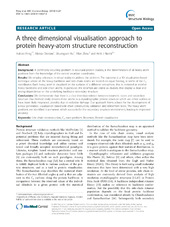A three dimensional visualisation approach to protein heavy-atom structure reconstruction
Peer reviewed, Journal article
Published version

Permanent lenke
https://hdl.handle.net/1956/9312Utgivelsesdato
2014-12-31Metadata
Vis full innførselSamlinger
Originalversjon
https://doi.org/10.1186/s12900-014-0027-8Sammendrag
Background: A commonly recurring problem in structural protein studies, is the determination of all heavy atom positions from the knowledge of the central α-carbon coordinates. Results: We employ advances in virtual reality to address the problem. The outcome is a 3D visualisation based technique where all the heavy backbone and side chain atoms are treated on equal footing, in terms of the Cα coordinates. Each heavy atom is visualised on the surfaces of a different two-sphere, that is centered at another heavy backbone and side chain atoms. In particular, the rotamers are visible as clusters, that display a clear and strong dependence on the underlying backbone secondary structure. Conclusions: We demonstrate that there is a clear interdependence between rotameric states and secondary structure. Our method easily detects those atoms in a crystallographic protein structure which are either outliers or have been likely misplaced, possibly due to radiation damage. Our approach forms a basis for the development of a new generation, visualization based side chain construction, validation and refinement tools. The heavy atom positions are identified in a manner which accounts for the secondary structure environment, leading to improved accuracy.
Utgiver
BioMed CentralTidsskrift
BMC Structural BiologyOpphavsrett
Copyright 2014 Peng et al.; licensee BioMed CentralXubiao Peng et al.; licensee BioMed Central Ltd.
